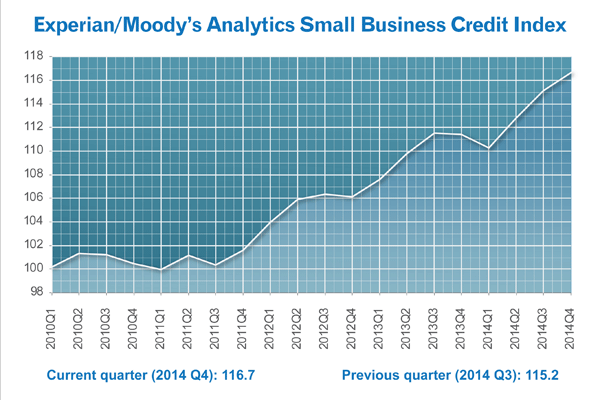Small business momentum bodes well
Companies riding high as credit quality continues its upward trend
- |
- Written by Dan Meder, Experian

“Momentum” is defined as the strength or force that allows something to continue or to grow stronger or faster as time passes. While most would associate the word momentum with an event, I believe momentum is the appropriate word to describe something else—the small-business lending environment.
Over the last several months, small businesses have experienced very positive trends. The Q4 2014 Experian/Moody’s Analytics Small Business Credit Index indicates that the job market continues to strengthen, consumer spending is on the rise, and the share of small-business credit balances past due have hit an all-time low.
As a result, small businesses have seen a consistent growth in the amount of trade credit available to them over the past three quarters. Understanding these trends can provide banks with insights that can enable them to make more sound lending decisions and mitigate risk.
Diving into the data
Much of the growth in credit availability can be attributed to small businesses improving their payment and credit-management behaviors across the board. In addition to delinquency rates dropping to new levels, small businesses on average have reduced the number of days to pay their bills by a full day, or 19.4% from the previous year.

The improvement in days to pay has helped improve the average commercial risk score* for small businesses, which has increased by 3.1% from a year ago, reaching 61.6. Bankruptcy rates have dropped by nearly 10.9% over the same time period.
From a regional perspective, the trends have maintained a fairly consistent pattern over the past few years. Small businesses in the West remain atop the list of those businesses that have experienced rejuvenation in credit quality, while those in the Northeast and Midwest lagged further behind. A main reason for the discrepancy is stronger job growth in the West. Additionally, depleting inventory in the housing market has helped construction companies in the region, as the need for more housing units has boosted job creation and cash flow.
Despite the Northeast and Midwest lagging behind in terms of credit quality, there are some signs of light at the end of the tunnel. Job growth has begun to pick up in both regions, and the number of residential construction permits has been increasing. While neither region is expected to surpass the West in the near future, the gap in credit quality should start to decrease as these trends take hold.
What do these insights mean for you?
At a high level, the data certainly paints a positive picture for banks and other financial institutions working with small businesses. Digging down a little deeper, there are additional insights that can help lenders take appropriate action when extending credit.
The improved payment performance across the board for small businesses holds a great deal of benefit for banks. As small businesses demonstrated an improved ability to make more timely payments on existing debts and the number of businesses filing for bankruptcy over the past year decreased, creditors can feel more confident when deciding on treatment of small-business loans.
With that said, it’s important to keep an eye on how these trends will continue into 2015. Macroeconomic data combined with business-payment performance data at the regional and industry levels will lead to a better understanding of progress in the small-business market. Banks, in turn, will have insights that are readily available to help them make better lending decisions and improve profitability. Small businesses are the lifeblood of the U.S. economy, and by helping them gain access to the funding they need, we’ll be able to continue the momentum that benefits us all.
About the author
Dan Meder is vice-president of Experian’s Business Information Services.
* Based on a scale of 1 to 100 (with 100 being least risky); predicts the likelihood of severe delinquency (more than 91 days past due) within the next 12 months
Tagged under Management, Financial Trends, Feature, Feature3,













